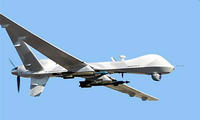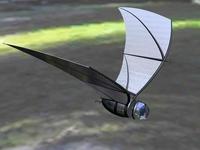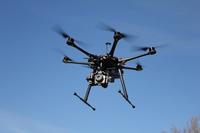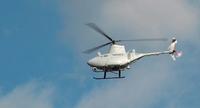-
EMS drone dramatically increases survival chances of heart attack patients, accident victims
A Dutch graduate student has designed an unmanned, autonomously navigating mini airplane that can quickly deliver a defibrillator to where it is needed. When the emergency services receive a cardiac arrest call, this drone can quickly deliver a defibrillator to the emergency scene. Via a livestream video and audio connection, the drone can also provide direct feedback to the emergency services and the persons on site can be instructed how to treat the patient. The drone finds the patient’s location through the caller’s mobile phone signal and makes its way to the location using GPS. The drone can carry up to four kilograms of medical equipment.
-
-
U.S. opens a second drone base in Niger
The Pentagon has reached an agreement with the government of Niger to open a second U.S. drone base in the landlocked country. The base, in the city of Agadez, will help the U.S. Air Force track Islamist militants who have gained control of remote parts of North and West Africa. U.S. and French troops already operate out of a military base in Niamey, Niger’s capital, where drones are set to conduct reconnaissance flights throughout the region.
-
-
Using drones in law enforcement work
Using unmanned flight systems for domestic surveillance can provide emergency responders information during fires, earthquakes, storms, and man-made disasters, said John Hill, director of the Indiana Department of Homeland Security.He said that the general public is open to the use of unmanned systems when informed about their use.
-
-
Firefighters mull using drones in fighting wildfires
Federal wildland firefighting officials are exploring the deployment of drones to assist in surveillance and reconnaissance missions during a wildfire. Drones sent to survey fire patterns during a wildfire could help keep firefighters out of risky situations by providing real-time information to officials on the ground. Few wildfire officials have used drones in the line of duty, and managers with the U.S. Bureau of Land Management(BLM) and U.S. Forest Servicesay that while the technology has potential, agencies do not have the budget and have not developed protocols to integrate drones into regular firefighting operations.
-
-
Current White House drone policy a “slippery slope”: Report
An 81-page report, released last Thursday by the Stimson Center and authored by a bipartisan panel of former intelligence and defense officials, warned that the present targeted drone strike policy could represent a “slippery slope” toward never-ending war. The report stresses that drone operations should always be “having a positive effect on U.S. national security and not trading short-term gains for more negative longer-term strategic consequences.”
-
-
Drones must be used wisely to help advance U.S. interests

A new report examines three key issue sets in the unmanned aerial vehicle (UAV) debate: defense utility, national security, and economics; ethics and law; and export controls and regulatory challenges. The report concludes that UAV technologies are here to stay. Used recklessly, UAVs can endanger U.S. interests and diminish regional and global stability. Used wisely, they can help advance U.S. national security interests in the midst of a more robust global commitment to the rule of law.
-
-
Drones are cheap, soldiers are not: a cost-benefit analysis of war
Cost is largely absent in the key debates around the use of unmanned drones in war, even though drones are a cost-effective way of achieving national security objectives. Drones will never completely replace soldiers, but the drone-vs.-human being debate is becoming less important in the current strategic climate. The operating environments where drones are deployed — countries such as Pakistan, Somalia and Yemen — do not emphasize “hearts and minds” strategies where the human element has traditionally been valued as a force multiplier. Instead, objectives in these countries involve attacks on specific individuals, with operational data obtained by signal intelligence beforehand. Human contact becomes even less desirable given that a key tactic of combatants in these weak states is attrition with the aim of creating low-level civil conflicts. The end goal of these actions is to inflict high economic costs to the adversary. As a result, this remote and analytical method of engaging militarily leads to substantial cost efficiencies.
-
-
New generation of aerial robots for high-risk missions
The need for robots able to carry out high-risk service tasks, such as the inspection of power plants and the cleaning of skyscrapers, is growing. Robots which actively interact with the environment without being constrained on the ground are well suited to such tasks.
-
-
Drones offer farmers eyes in the sky to check on crop progress

Commercial use of unmanned aerial vehicles in U.S. airspace was banned by the Federal Aviation Administration in 2007, although growing numbers of hobbyists have been toying with the use of drones, particularly for aerial photography. Facing mounting pressure from agribusiness, retail, and other industries, however, the FAA is expected to release new policies by 2015 that will enable businesses to integrate drones into their operations. The agriculture industry is expected to be one of the largest market segments for drone usage. This growing season, crop researchers at the University of Illinois are experimenting with the use of drones on the university’s South Farms. A crop sciences educator is using two drones to take aerial pictures of crops growing in research plots on the farms.
-
-
Nature-inspired designs for drones of the future

Based on the mechanisms adopted by birds, bats, insects, and snakes, fourteen research teams have developed solutions to some of the common problems that drones could be faced with when navigating through an urban environment and performing novel tasks for the benefit of society. Whether this is avoiding obstacles, picking up and delivering items, or improving the take-off and landing on tricky surfaces, it is hoped the solutions can lead to the deployment of drones in complex urban environments in a number of different ways, from military surveillance and search and rescue efforts to flying camera phones and reliable courier services.
-
-
Drone surveillance raises legal, ethical concerns

The use of drones for domestic security purposes, surveillance of citizens, and putative criminals and organizations raises many legal and ethical concerns particularly with regard to the Fourth Amendment to the U.S. Constitution, Council of Europe instruments, and the EU Data Protection Framework. Experts suggest that the rise of drones for surveillance and other applications highlights particular challenges to civil liberties and tensions between these and national security and justice concerns.
-
-
FAA grants NJIT permission to test UAVs

On 8 May the FAA awarded the New Jersey Institute of Technology (NJIT) a Certificate of Waiver/Authorization (COA), making it the first New Jersey university and first public institution in the state granted permission to test the unmanned aircraft systems (UAS). NJIT will use the airstrip on the U.S. Coast Guard Training Center in Cape May to test the systems.
-
-
Fairbanks, Alaska UAV test site conducts first flight test
The Pan-Pacific Unmanned Aircraft Systems Test Range Complex at the University of Alaska Fairbanks was established last year to help the Federal Aviation Administration (FAA) develop regulations and certifications for unmanned aircraft operators and equipment. The goal is to integrate them into the National Airspace System. On Monday, an Aeryon Scout mini quadcopter was the first UAV to be tested at the range. The range is the second of six UAV test sites to receive an FAA’s Certificate of Authorization.
-
-
U.S. drone attacks kill at least 55 al-Qaeda militants in Yemen
A series of U.S. drone strikes Sunday and Monday killed at least fifty-five al-Qaeda militants in Yemen. The operation focused on al-Qaeda operation basecamps in the rugged mountain of the central and southern provinces of Yemen. Yemeni government sources to say that the first series of attacks, carried out on Sunday, killed three prominent al-Qaeda operatives. Al-Qaeda made gains in Yemen during the chaos which accompanied the 2011 popular uprising against then-President Ali Abdullah Saleh, who was driven from power a year later. In the last two years, the United States and the new Yemeni government have escalated the fight against the Islamist militants.
-
-
U.S. lags behind other countries in commercial use of drones
As the United States continues to explore regulations and safety guidelines for commercial UAVs, other countries have already adopted their use. Photographers, real estate agents, filmmakers, and news agencies in the United States want to use drones in their operations, but the FAA insists that rules addressing safety challenges associated with drones need to be in place before drones can share the sky with manned aircrafts.
-
- All
- Regional
- Water
- Biometrics
- Borders/Immig
- Business
- Cybersecurity
- Detection
- Disasters
- Government
- Infrastructure
- International
- Public health
- Public Safety
- Communication interoperabillity
- Emergency services
- Emergency medical services
- Fire
- First response
- IEDs
- Law Enforcement
- Law Enforcement Technology
- Military technology
- Nonlethal weapons
- Nuclear weapons
- Personal protection equipment
- Police
- Notification /alert systems
- Situational awareness
- Weapons systems
- Sci-Tech
- Sector Reports
- Surveillance
- Transportation
Advertising & Marketing: advertise@newswirepubs.com
Editorial: editor@newswirepubs.com
General: info@newswirepubs.com
2010-2011 © News Wire Publications, LLC News Wire Publications, LLC
220 Old Country Road | Suite 200 | Mineola | New York | 11501
Permissions and Policies
Editorial: editor@newswirepubs.com
General: info@newswirepubs.com
2010-2011 © News Wire Publications, LLC News Wire Publications, LLC
220 Old Country Road | Suite 200 | Mineola | New York | 11501
Permissions and Policies
